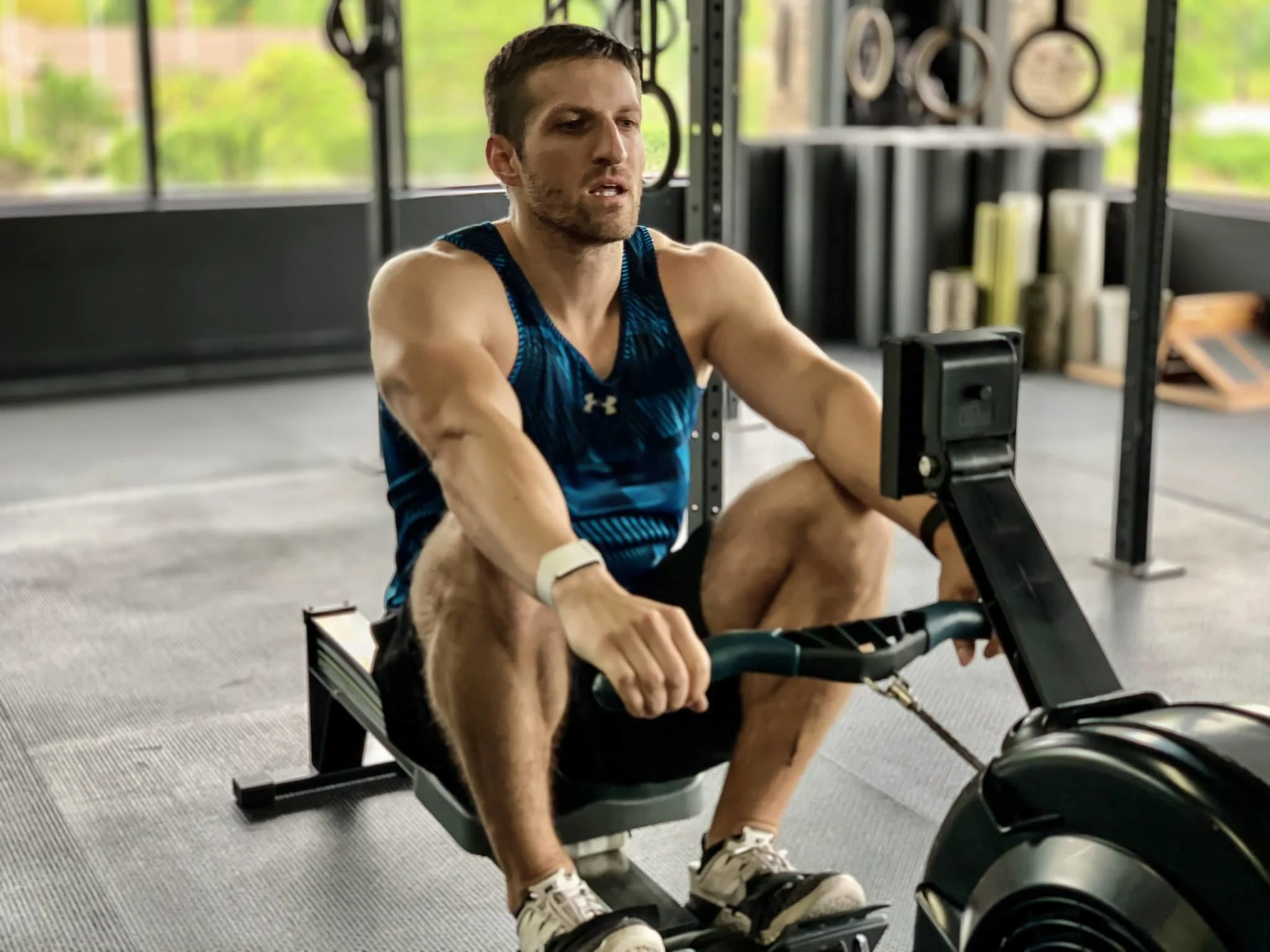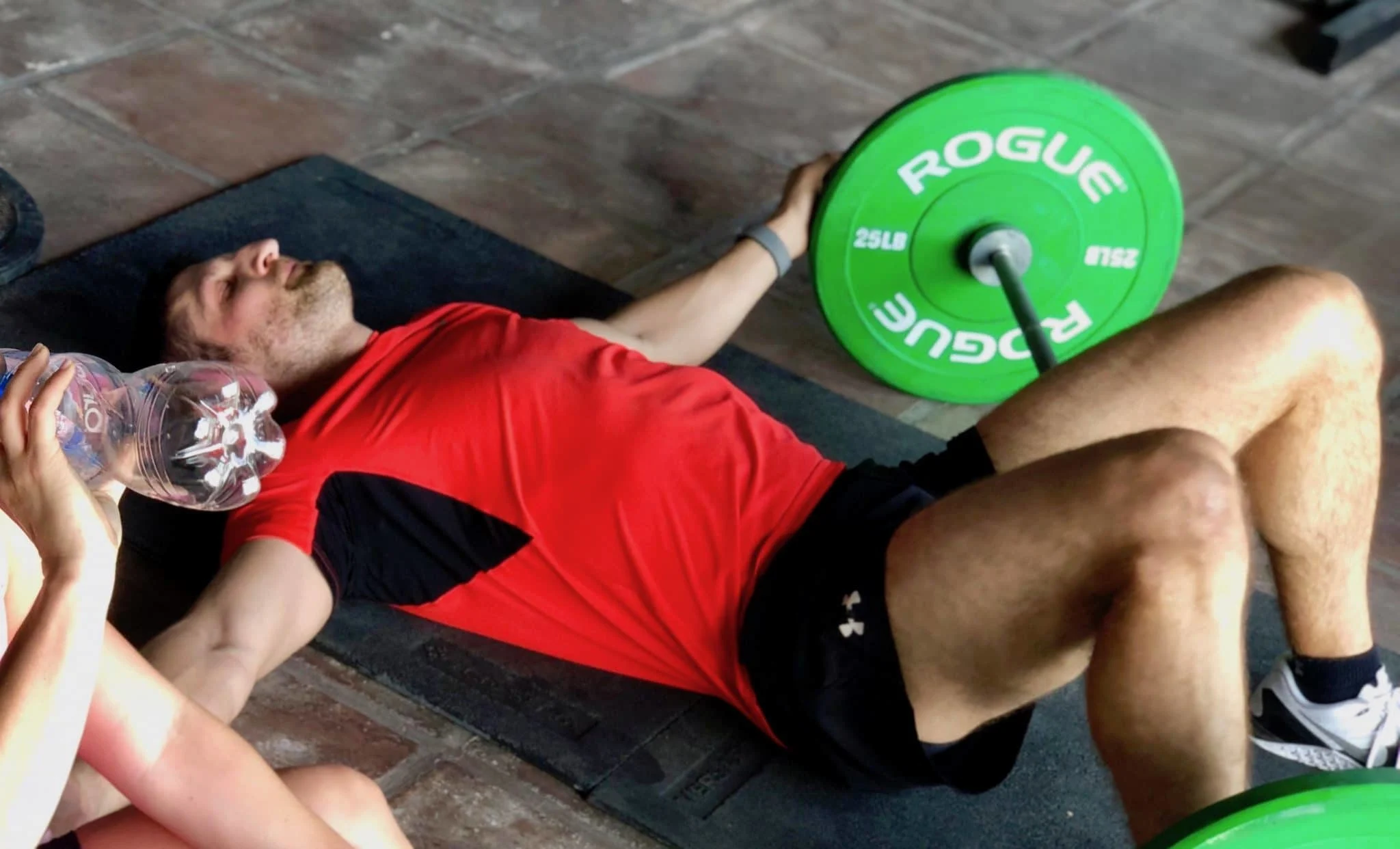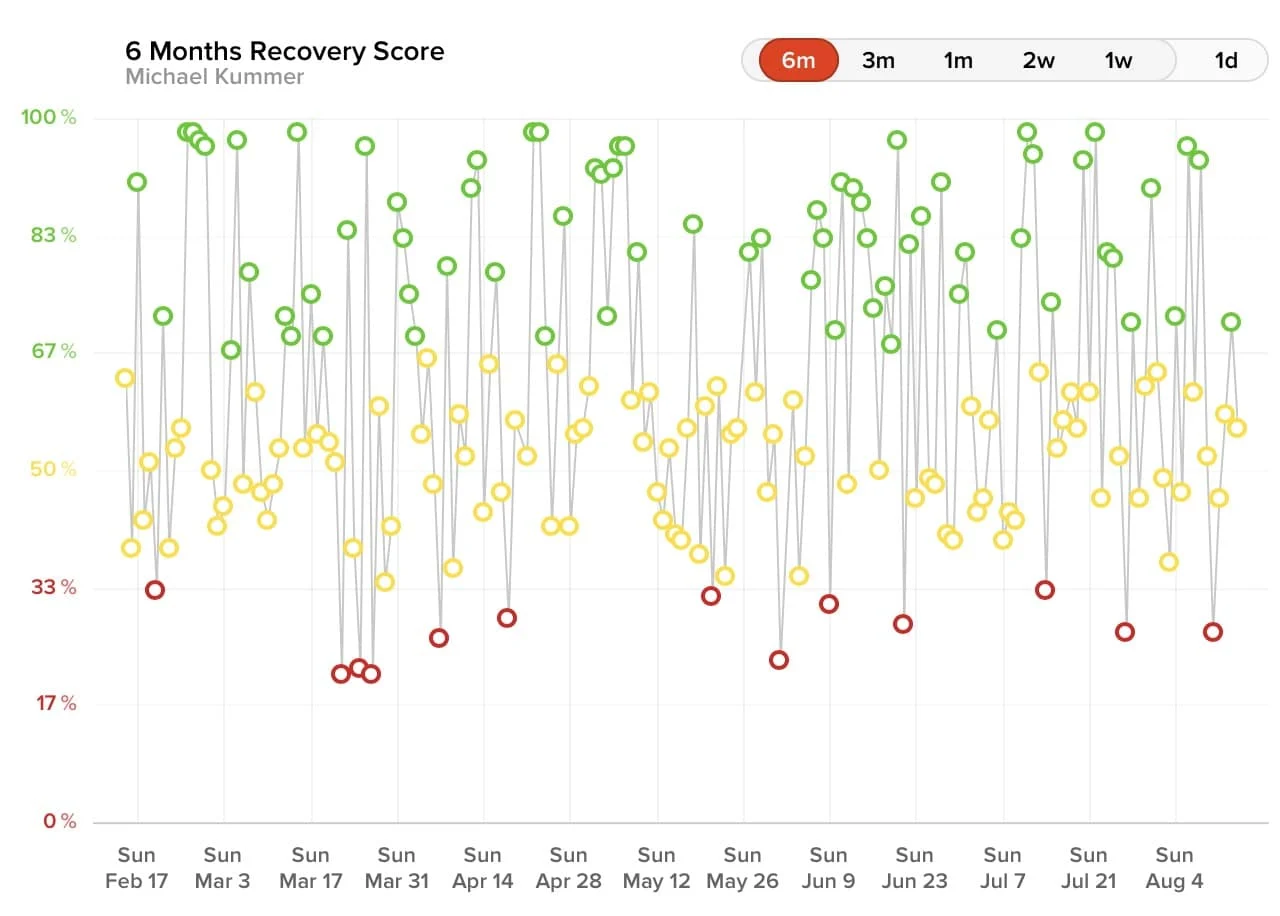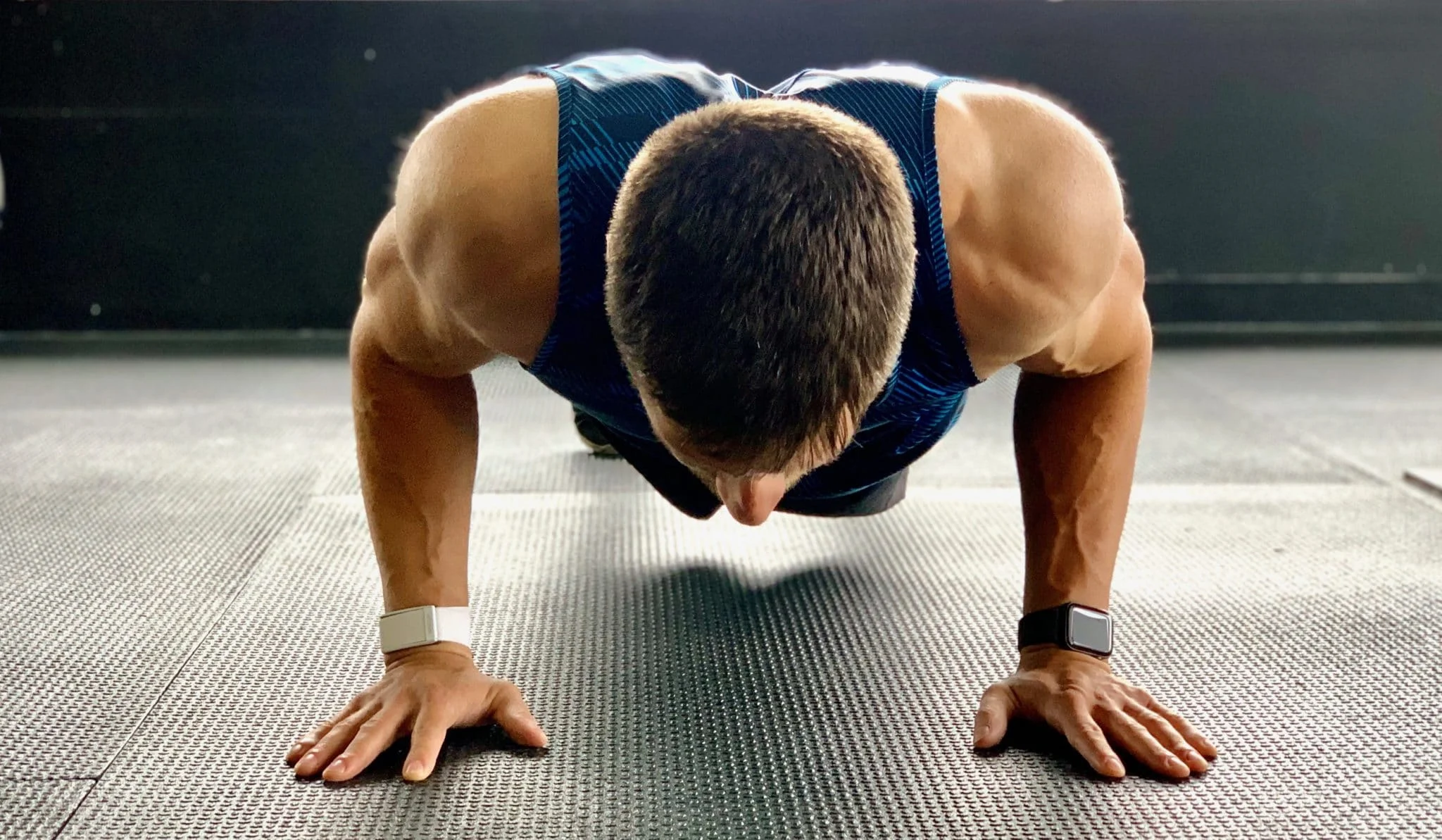Topics
- Article
- Training & Exercise
How Hard Should You Push Yourself When Exercising?

In this post, I’ll share some of the lessons I’ve learned since retiring from my career as a professional athlete.
For most of my life, I went all-in during every workout. If I wasn't on the floor in pain, trying to suppress the urge to vomit, I felt like I hadn’t pushed myself hard enough. In this post, I’ll share some of the lessons I’ve learned since retiring from my career as a professional athlete. I’ll also explain how tools like WHOOP have helped me change my attitude towards performance and recovery, and better answer the question "How hard should you work out?" At the end, I'll share my Top 8 tips for getting fitter and healthier while reducing your risk of injury—regardless of how fit you are today.
Work Harder Than The Competition
I’ve always been a person who is motivated to do my best at everything I do. For sports, and my former career as a professional track and field athlete, that meant pushing myself harder than my competitors. My goal was to give 100% maximum effort 100% of the time. I figured that if I didn’t "redline" at every workout, someone else would—and they’d get a step ahead of me because of it. In my early 20s, I was a 100-meter sprinter representing Austria in international competition. I remember times when I felt proud and accomplished after workouts, despite laying on the track next to the contents of my stomach. The puke was proof that I had worked harder than anyone else—or at least as hard as my body could handle. It was literally a fierce battle between my mind and my body (one that my mind usually won).

After I ended my sports career, I moved to the United States. That was back in 2007, and at that time I was only exercising sporadically, lifting weights with friends or running a few times a week. But even then, I couldn't help but push myself and max out my effort. After running, I would lie in my driveway, drenched in sweat and gasping for air. One day, a neighbor saw me and ran over to ask if I needed medical attention. I guess I must have looked especially exhausted that day.
CrossFit Rekindled My Passion For "Pushing It"
In 2017, inspired by a friend and our neighbors who coach at CrossFit Alpharetta (near Atlanta), I signed up for CrossFit. Even though I had no aspiration to become a professional athlete again, CrossFit rekindled my passion for fitness—and for pushing my aging body to its limits. My wife used to make fun of the fact that I was the only one lying on the floor for 10 minutes after every workout. Everyone else was cleaning up their equipment and getting ready to head home, but I didn't care. I was still convinced that I would only improve by pushing myself to the limit every time I hit the gym.

Why Does Everyone Get Hurt at CrossFit?
It's now 2019, and my performance has improved dramatically since I started CrossFit two years ago. But that improvement has not come without numerous aches and injuries. I wasn't surprised by those setbacks. Everyone warned me that I would get hurt doing CrossFit. That's just how it goes, they said. But why? After one-and-a-half years of doing CrossFit, I got to a point where I could only work out three or four times a week, instead of the five or six times that was my norm when I first started out. My body started hurting so much that I needed more time to recover.
The Importance of Learning to Hold Back
Around that time, the owner of our box introduced us to a concept called heart rate training. The idea behind that is to keep tabs on your heart rate, and to perform several workouts a week at low to medium intensity (while keeping your heart rate under a certain threshold). The goal of heart rate training is to improve your cardio capacity by increasing the threshold at which the body switches from fat to glycogen as its primary source of energy during a workout.

Many athletes in our box were skeptical about that concept because they didn't see the sense in working out at such low intensity. I took heart rate training as an opportunity to free myself from the need to compete—against myself and others. Instead, I could simply perform the exercises with little mental or physical stress. In other words, I learned to be OK with not claiming the top spot on the leaderboard at the end of the day. As a result, I could work out more often without feeling overtrained and beaten up.
How WHOOP Has Visualized My Recovery
A few weeks after I changed my approach to CrossFit, a fellow athlete introduced me to a fitness tracker called WHOOP and suggested that I review it on my blog. I reached out to WHOOP and they graciously sent me a review unit to test. Frankly, I didn't expect much. But I wanted to find out how WHOOP compared to the Apple Watch, which is what I had been using to track my workouts. However, when I learned about the treasure trove of data that WHOOP provides—combined with actionable analytics—I got hooked. I've been wearing both the Apple Watch and WHOOP ever since, and strongly recommend the latter to my friends and fellow athletes. What I really like about WHOOP is how it uses my biometric data to provide insight into how recovered I am and how much strain my body can handle on a given day.

By wearing WHOOP 24/7, the band keeps constant tabs on my resting heart rate, strain, quality of sleep and heart rate variability (an important indicator of how my nervous system is doing). In other words, WHOOP can tell me how my sleep and daily stress—in addition to the physical stress from working out—affects my recovery and my ability to take on additional strain.
How My Workout Attitude Has Changed
I still have a very competitive mindset. But I've realized that redlining at every workout is unsustainable and ineffective. Letting my body win out over my mind is still a daily challenge. Over the years I built a habit of kicking my own butt, and it’s difficult to un-learn that proclivity. But I've seen how much better I feel—and how much quicker I progress—by letting go of the desire to be first every time. WHOOP has helped me evolve from a brute-force competitor to a sophisticated athlete, and my fitness is better because of that.
8 Sustainable Tips for Improving Your Athletic Performance
Here are eight tips that I’ve incorporated into my training regimen. These steps have helped me feel better, improve my performance, reduce my stress and limit my risk of injury. 1. Acknowledge external stress 2. Be protective of your sleep 3. Maintain a healthy diet 4. Listen to what your body is trying to tell you 5. Learn to appreciate lower-intensity training sessions 6. Practice mindfulness 7. Treat recovery as important as you treat strain 8. Remember your (fitness) goals
1. Acknowledge External Stress
Daily stress can be more detrimental to your performance on a given day than physical strain from a previous workout. It's important to acknowledge that, and to adapt your training and workout plan accordingly. If you show up at the gym all stressed out, don't expect great results. Instead, take a few minutes to disconnect; consider leveraging breathing exercises, and scale your workout (if necessary). That might mean slightly less-intense strength training or performing a metcon WOD at less intensity.
2. Be Protective of Your Sleep
Sleep is arguably the most important of the three pillars that make up a healthy lifestyle—diet and exercise being the other two. So it's important to protect your sleep at all costs, because it's crucial for your recovery, performance and overall well-being. I go to bed at 9 p.m. every night and wake up at 5 a.m. That sleep consistency not only ensures that I get enough sleep in general, it also increases my chances of getting enough restorative sleep (REM and deep sleep).
3. Maintain a Healthy Diet
Food is fuel for your body. If you maintain an unhealthy diet, don't expect great performance. You should also realize that you can't out-exercise a bad diet. When I was a young athlete, I figured I could eat whatever I wanted—as long as I worked out 13 times a week. Unfortunately, that was, and is, a misconception. Learn as much as you can about food and its impact on your well-being. That way, you can use it as a tool to maximize your health and performance.
4. Listen to What Your Body is Trying to Tell You
WHOOP collects and visualizes actionable data that can help you better understand your body and tweak your training schedule and workout plan. Every morning, I open the WHOOP app and check my heart rate variability (HRV), recovery score, and sleep analysis. I approach my workouts based on that data (as well as feedback from my body), and use that information to pursue my fitness goals more efficiently.
5. Learn to Appreciate Lower-Intensity Workouts
I've learned that by not getting caught up in competing for the No. 1 spot on the leaderboard, I actually have time and energy to focus on the quality of my movements. Additionally, I’ve noticed that I'm suddenly more aware of what's going on around me during a workout. It’s like running through the forest and hearing the bees hum and the birds chirp, as opposed to being so focused on your run that you hardly notice you’re in a forest. In the past I had tunnel vision, so that realization has been incredibly satisfying and it has reduced the psychological stress of workouts tremendously.

6. Practice Mindfulness
When I first discovered the "Breathe" app I figured it was a useless gimmick. I tried it once or twice, but didn't see the purpose of it. Now that I've realized the benefits of mindfulness and breathing, I use it several times a day. It helps me relax, reduce tension, and momentarily disconnect from everything that's going on around me.
7. Treat Recovery as Important as You Treat Strain
For many athletes, recovery is often seen as a luxury they can't afford (or don't have time for). I have a daily reminder to stretch. But guess what? More often than not, I don't get around to it because "I don't have time." However, stretching is only one of the methods I use for recovery. Others include:
- Breathing
- Active recovery—completing a workout at lower intensity than usual
- Getting a good night's sleep
As you can see, recovery doesn't necessarily require additional time, you can simply weave it into your daily routine.
8. Remember Your Goals
Don't forget why you started working out in the first place. If improving your overall health is your primary goal—as opposed to competing at the CrossFit Games—"redlining" at every workout might feed your ego, but it won't make you any healthier. It's all too easy to get wrapped up in the competition… even if it's only for the top spot on the local leaderboard. I've found myself in that situation several times over the past two years, but then I remembered why I started CrossFit in the first place—to complement my healthy lifestyle, reduce the risk of developing chronic diseases, and improve my functional fitness. To achieve those goals, it doesn't matter where I end up on the leaderboard. Plus, being aware of your fitness goals doesn't mean that you can't also be competitive. I still push myself when the time is right, I just no longer feel like I’m missing out—or letting myself down—when I don’t.
Final Words
As of this writing, I'm 37 years old. According to WebMD, our fitness levels start naturally declining after our 20s. As a result, you might think that I was much fitter in my 20s—as a professional athlete—than I am now. Interestingly enough, my metabolic conditioning is far superior now. And just a few weeks ago, I achieved a new 1 rep max clean. Today I'm stronger than ever. I have more endurance, I feel and sleep better, and I have better body composition. What that tells me is that I wasn’t tapping into my full potential when I was in my 20s. Instead, I overtrained, fed my body the wrong food, and thought getting a solid seven or eight hours of sleep was a luxury I couldn't afford. The good news is that it's never too late to change those patterns. Learn how to not kill yourself at every workout and you'll see positive results sooner than you'd expect.